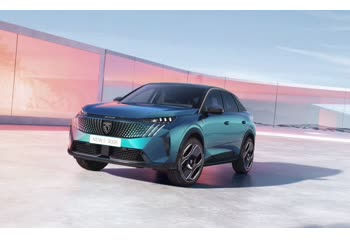Everything you need to know about specifications and performance - Peugeot 3008 2019 - 1.6 Hybrid4 (300 Hp) e-EAT8

Overview:
What is the engine capacity of a Peugeot 3008 2019?
The engine capacity of the Peugeot 3008 2019 is 1598.
Peugeot 3008 2019 How many horsepower?
The engine power of the Peugeot 3008 2019 is 200 Hp @ 6000 rpm..
What is the Peugeot 3008 2019 engine?
Peugeot 3008 2019 engine is 5GB EP6FADTXHPA. (Click to see other cars using the same engine)
How powerful is the electrical system in the Peugeot 3008 2019?
The power of the electrical system in the Peugeot 3008 2019 is 300 Hp hp.
How much gasoline does a Peugeot 3008 2019 consume?
The Peugeot 3008 2019 consumes 1.5 liters of gasoline per 100 km
General:
Brand: Peugeot
Model: 3008
Generation: II (Phase I, 2016)
Modification (Engine): 1.6 Hybrid4 (300 Hp) e-EAT8
Start of production: 2019
End of production: 2020
Powertrain Architecture:Plug-In Hybrid Electric Vehicles (PHEVs)
Body type:Sports Utility Vehicle (SUV)
Seats: 5
Doors: 5
Engine:
Engine systems: Start & Stop System
Power: 200 hp @ 6000 rpm.
Power per litre: 125.2 hp/l
Torque: 300 nm @ 3000 rpm.
Engine Model/Code:5GB EP6FADTXHPA
Engine displacement: 1598
Number of cylinders: 4
Engine configuration: Inline
Number of valves per cylinder: 4
Fuel injection system: Direct injection
Engine aspiration: Turbocharger, Intercooler
Valvetrain: DOHC
Engine oil capacity: 4.25 l
Engine layout: Front, Transverse
Cylinder Bore: 77 mm
Piston Stroke: 85.8 mm
Compression ratio: 10.2:1
Performance:
Fuel Type: Petrol / electricity
Combined fuel consumption (WLTP): 1.3 l/100 km
Fuel consumption (economy) - combined (NEDC): 1.5 l/100 km
Fuel consumption (economy) - combined: 1.5 l/100 km
Emission standard: Euro 6d
Acceleration 0 - 100 km/h: 5.9 sec
Acceleration 0 - 62 mph: 5.9 sec
Maximum speed: 240 km/h
Weight-to-power ratio: 6.1 kg/Hp, 163 Hp/tonne
Weight-to-torque ratio: 3.5 kg/Nm, 282.6 Nm/tonne
Max speed (electric): 135 km/h
Acceleration 0 - 60 mph: 5.6 sec
Electric system:
Gross battery capacity: 13.2 kWh
Battery technology: Lithium-ion (Li-Ion)
Battery location: Below the floor, under the rear seats
System power: 300 hp
System torque: 520 nm
All-electric range: 57-59 km
Electric motor power: 110 hp @ 2500 rpm.
Electric motor Torque: 320 nm @ 500-2500 rpm.
Average Energy consumption: 15.2-15.6 kWh/100 km
Electric motor location: Between the combustion Engine and the transmission
Average Energy consumption (WLTP): 15.2-15.6 kWh/100 km
All-electric range (WLTP): 57-59 km
Space:
Kerb Weight (kg): 1840
Max. weight (kg): 2330
Max. roof load: 80 kg
Max load (kg): 490
Trunk (boot) space - maximum: 1357 l
Trunk (boot) space - minimum: 395 l
Permitted trailer load with brakes (12%): 1250 kg
Fuel tank capacity: 43 l
Permitted trailer load without brakes: 750 kg
Permitted towbar download: 64 kg
dimensions:
Length: 4447 mm
Width: 1841 mm
Height: 1615 mm
wheelbase: 2675 mm
Width with mirrors folded: 1906 mm
Width including mirrors: 2098 mm
Front track: 1579-1601 mm
Rear (Back) track: 1587-1610 mm
Front overhang: 923 mm
Rear overhang: 849 mm
Ride height (ground clearance): 219 mm
Minimum turning circle (turning diameter): 10.67 m
Approach angle: 20°
Departure angle: 29°
Powertrain, Suspension and Brakes:
Drivetrain Architecture: An Internal combustion Engine (ICE) drives the front wheels, one electric motor drives the front wheels, one electric motor drives the rear wheels. There is an ability for running in full electric or mixed mode.
Drive wheel: All wheel drive (4x4)
Number of gears and type of gearbox: 8 gears, automatic transmission e-EAT
Front brakes: Ventilated discs
Rear brakes: Disc
Assisting systems: ABS (Anti-lock braking system)
Steering type: Steering rack and pinion
Power steering: Electric Steering
Tires size: 225/55 R18; 205/55 R19
Wheel rims size: 18; 19
Front suspension: Independent type McPherson
Rear suspension: Semi-independent, coil Spring
See also

Last generation.
Its production began in 2023 until Now

Write a comment